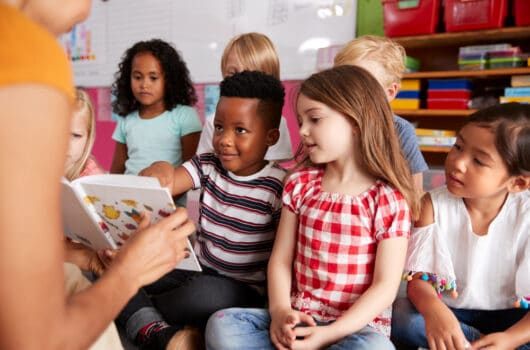When your child turns six, they are reaching an age where supporting and helping them develop their reading skills is crucial to their literacy development. At this age, children are focused more on learning how to read than they are on reading to learn, so fiction will most likely be a six-year-old’s go-to genre.
However, reading for information will also be a critical skill for beginning readers to develop at this age, with the support of their teachers and parents. There are only two musts when it comes to reading at this age: encourage your six-year-old to read whatever they’re interested in and read together every day.
- What to Look for in Books for 6-Year-Olds
- Top 20 Best Books for 6-Year-Olds 2023
- 1. Best Overall Book for 6-Year-Olds: Where the Wild Things Are by Maurice Sendak
- 2. Best Premium Book for 6-Year-Olds: What Should Danny Do? by Adir and Ganit Levy
- 3. Best Budget Book for Six-Year-Olds: The Book with No Pictures by B.J. Novak
- 4. Best Non-Fiction Book for Six-Year-Olds: 5,000 Awesome Facts (About Everything) by National Geographic Kids
- 5. Best Book Series for Six-Year-Olds: How to Catch a Mermaid by Andy Elkerton
- 6. Best Poetry Book for Six-Year-Olds: Where the Sidewalk Ends by Shel Silverstein
- 7. Best Rhyming Book for Six-Year-Olds: One Fish, Two Fish, Red Fish, Blue Fish by Dr. Suess
- 8. Best Book for Advanced 6-Year-Old Readers: Dog Man, The Epic Collection #1-3 Box Set by Dav Pilkey
- 9. Best Sing-Along Book: Pete the Cat: I Love My White Shoes by Eric Litwin
- 10. Best Book for Empowering Six-Year-Old Girls: The Paper Bag Princess by Robert Munsch
- 11. Best Book for Joke-Lovers: Awesome Jokes that Every Six-Year-Old Should Know by Mat Waugh and Yurko Rymar
- 12. Best Book for Curious Minds: Ada Twist, Scientist by Andrea Beaty
- 13. Best Interactive Book: Don’t Let the Pigeon Drive the Bus! by Mo Willems
- 14. Best Book for Showing Different Perspectives: The True Story of the Three Little Pigs by Jon Scieszke
- 15. Best Book for Encouraging Creativity: The Dot by Peter H. Reynolds
- 16. Best Humorous Book: We Don’t Eat Our Classmates by Ryan T. Higgins
- 17. Best Book for Reading with Grandparents: Last Stop on Market Street by Matt de La Peña
- 18. Best Book for Breaking Male Stereotypes for Six-Year-Old-Boys: Julián is a Mermaid by Jessica Love
- 19. Best Book for Beginning Readers: We Are in a Book! (An Elephant and Piggie Book) by Mo Willems
- 20. Best Book to Read with Teachers: Miss Nelson is Missing by Harry G. Allard
- Final Thoughts on Books for 6-Year-Olds
What to Look for in Books for 6-Year-Olds
The most important thing to consider when choosing a book for your little one is finding something that interests them. But beyond that, there are some developmental benefits and other things worth considering when picking out the perfect book.
How Do Six-Year-Olds Read?
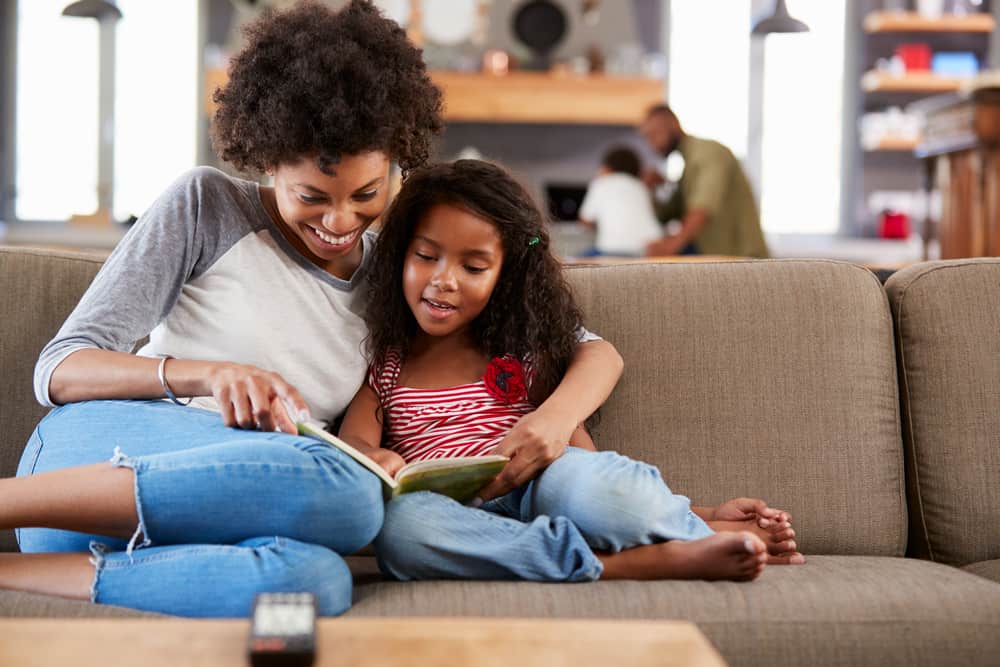
At this age, most kids are learning how to read. Six-year-olds go through a rapid development process when it comes to reading, so don’t be surprised if you notice a surge in their vocabulary. This means that they are reading loads, and that’s a good thing!
Here are some ways they are learning how to read that you can encourage with the books on our list.
Sight Words
These are commonly used words (e.g. it, the, and, etc.). At this age, six-year-olds should start learning how to read sight words automatically. Most books for six-year-olds will have plenty of sight words for your child to practice recognizing in a text. You can also practice sight words with flash cards at home.
Decoding & Phonics
These are words that fit into different sound groups (e.g. -og words like: dog, pog, fog, etc.). Six-year-olds are learning more about letter-sound relationships and how to use that knowledge to read words that are new to them. Be sure to choose books that showcase different letter-sound patterns.
Rhyming and poetry books are excellent for practicing phonics.
Fluency
While it is important for six-year-olds to learn how to decode and recognize sight words, it is equally important that they learn how to read with fluency. This means that they can read sentences in phrases and with the appropriate expression at an even pace. It’s a tricky skill to learn, but if you choose a variety of books that use different size letterings, fonts and appearances in their text, it can physically show students how to read many phrases and different expressions.
Mo Willems’s Don’t Let the Pigeon on the Bus! is an excellent book to help your child practice fluency.
What Kind of Books Are at the Right Reading Level for My 6-Year-Old?
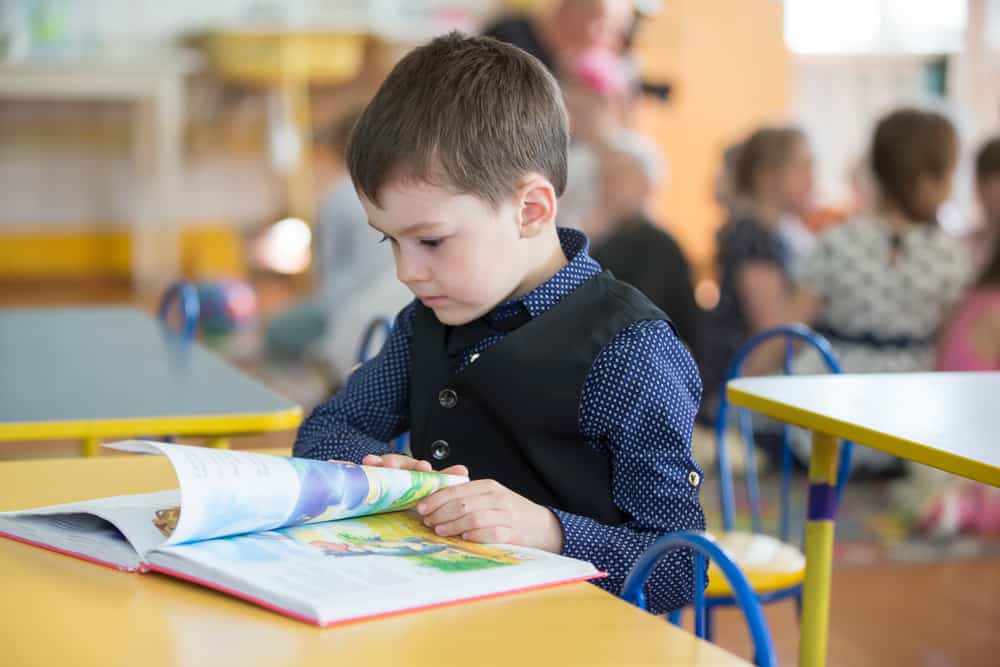
Make sure you use the “Five Finger Rule” when choosing books that are at an appropriate level for your kids. Pick a random page and ask your child to hold up a finger for every word they don’t know. If they hold up five fingers you should probably look elsewhere, while four will probably require your assistance and 3 should be challenging but readable.
Not every book has to be at their exact reading level, but having a good selection of books that they can quickly learn how to read on their own is important when choosing the best kinds of books for your six-year-old.
The other important factor is to choose books that are about topics that your child is interested in. Whether it’s trucks or princesses or buildings or flowers, your child will want to open up and explore the books you buy them if they like the subject matter.
Other Key Features to Look Out For

There’s more to choosing the perfect book than ensuring it appeals to your child and will have developmental benefits. Books can entertain, inspire, and educate, so keep these features in mind during your search.
Illustrations
Believe it or not, reading is not just about the words: it’s also about being able to read the clues in the illustrations. Engaging illustrations are a critical feature to look out for in the books for your six-year-old.
Not only do they make reading new words feel less scary, but they also give your child the chance to demonstrate other equally important reading skills like making inferences and critical thinking. Even as your child reaches more advanced reading levels, picture books with awesome illustrations are still important to keep in the mix!
Learning Opportunities
Most books for this age group will share wonderful stories where the main characters learn important lessons. Because your six-year-old is also learning critical social skills like sharing, making friends and positively resolving conflicts with others, it is important for them to see these behaviors in the books they read.
It is also equally valuable to choose books that represent diversity. So pick out books with characters who are in wheelchairs; or books where girls are the hero; or books where the boys like pink. The important thing is to show your child a world where differences exist and are celebrated through the books they read.
Book Awards
Now, this is not the most important thing that makes or breaks a good book for a six-year-old. But winning popular children’s book awards like the Caldecott or the Newbery Medal is an important factor to consider when choosing quality books for your child. These are books that have been singled out as exemplary works of children’s literature, and that’s not something to take for granted!
Now that you know what to look for, let’s take a look at some options for finding your little one’s favorite book yet!
Top 20 Best Books for 6-Year-Olds 2023
1. Best Overall Book for 6-Year-Olds: Where the Wild Things Are by Maurice Sendak
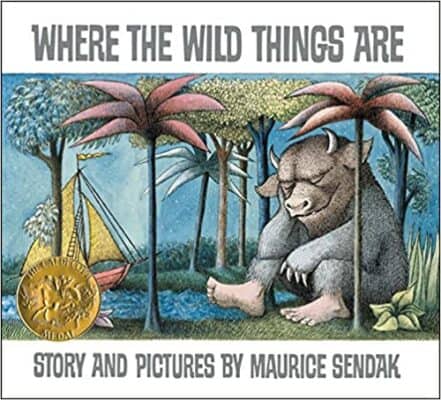
Editor’s Rating:
Quick Facts:
- Reading Level: Ages 4-8
- Pages: 48
- Book Awards: Caldecott Medal
Max is a young boy who loves to be wild. When his mother sends him to bed without dinner because he is behaving poorly, Max falls fast asleep. When he wakes up, his room has turned into a forest at night. He jumps into a boat that takes him to a place far away from home and his mom’s rules. Max travels to where wild things live and joins in on the rumpus!
Some parents have found the monsters in the story to be too scary, though, so you may want to look over the content before you purchase it.
Why Your Six-Year-Old Might Like It
The first thing that will pull your six-year-old into this story are the vivid illustrations. They will enjoy exploring every detail of each scene Max discovers. Adding to this, Max’s character is relatable. He doesn’t like rules, and he just wants to be wild. What six-year-old hasn’t felt this way?
Reading Practice
The text is very simple to follow, and there are not too many words on each page. This means that your child will be able to practice tracking and recognizing sight words without feeling too overwhelmed by the number of words.
There are also slight changes to the font to help encourage your child to read with expression. For example, when Max yells, his words are in all capital letters (e.g. Max said, “I’LL EAT YOU UP!”), encouraging your child to speak with a loud voice.
Learning Opportunities
Where the Wild Things Are is an excellent story that teaches your child that there is a right place and a right time for certain emotions. It also teaches children how to cope with feelings of anger while reinforcing that your parents will still be there for you, even when you make mistakes.
Pros
- Great for practicing reading with expressions
- Positive lessons about dealing with anger
- Reinforces that parents love their children
Cons
- Monsters in the story may be scary for some kids
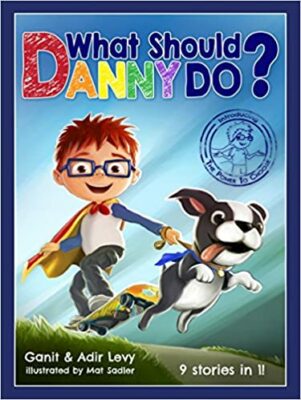
Editor’s Rating:
Quick Facts:
- Reading Level: Ages 3+
- Pages: 68
- Book Awards: NAPPA Award
Danny is a super-hero-in-training who comes across different scenarios throughout his day. With each encounter, the reader gets to decide what choice Danny should make! Some parents have said there was not enough emotional support from parents exemplified in the story, but the book does a good job of empowering children to make their own choices.
Why Your Six-Year-Old Might Like It
Your child will love being able to actively engage in the story’s plot! Danny’s situations in the story are based on things kids face in their own everyday lives, making his character relatable. Having the power to make their own choices is extremely important at this age, so experiencing it first-hand through an interactive story will make this book a quick favorite.
Reading Practice
Although this book may be best as a read aloud for beginning readers, certain parts of the text are written in various fonts or colors to help your child practice reading with expression. The use of question marks, exclamation points and ellipses also present great opportunities for children to learn how to read sentences and phrases using these types of punctuation with the proper expressions.
Learning Opportunities
This book is all about making choices and dealing with the consequences of them. You and your child will have multiple opportunities to talk about how and why different choices lead to specific outcomes. Your child will learn that they only have control over their own actions and that making a good choice doesn’t always line up with what they want.
Pros
- Excellent learning opportunities about choices and consequences
- Main character’s choice scenarios are relatable to kids
- Use of punctuation engages reading with expression
Cons
- Main character has to make good choices without his parent’s support
3. Best Budget Book for Six-Year-Olds: The Book with No Pictures by B.J. Novak
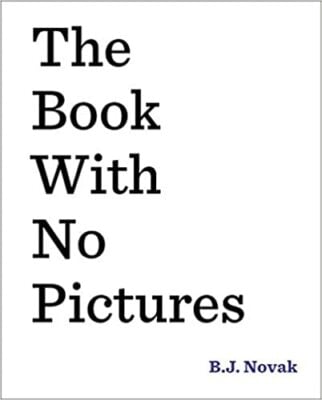
Editor’s Rating:
Quick Facts:
- Reading Level: Ages 5-8
- Pages: 48
- Book Awards: California Young Reader Medal
This book is all about the rules of reading when there are no pictures, and it does not disappoint. Each page must be read aloud by the reader, no matter what the words say. That’s the rule! The story is full of fun and silly sentences that will make kids laugh out loud. Some parents found that there is not enough content per page, but kids often love reading it again and again.
Why Your Six-Year-Old Might Like It
This book is pure silliness, something every six-year old will love! It’s also a story that is unique and unlike anything else your child will read, sparking their curious nature.
Reading Practice
Not only do the differing fonts and text sizes engage young readers to read with fluency and expression, but the silly nonsense words will also engage your child to practice letter-sound relationships through decoding practice.
Learning Opportunities
Your child will learn how to use their imaginations when listening to or reading each page. Illustrations are great, but engaging your child’s own imagination when reading is also an excellent learning experience.
Pros
- Engages children in practicing decoding skills
- Encourages laughter and silliness
- Children get to use their own imaginations
Cons
- Some parents dislike the lack of content per page
4. Best Non-Fiction Book for Six-Year-Olds: 5,000 Awesome Facts (About Everything) by National Geographic Kids
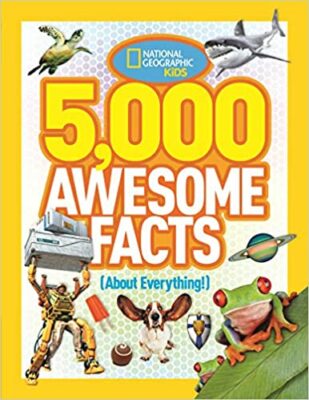
Editor’s Rating:
Quick Facts:
- Reading Level: Ages 8-12
- Pages: 224
There’s no plot to this one. Each two-page spread is filled with interesting pictures and facts about different topics that kids will find super interesting. Does your kid want to know more about sharks? Or robots? Want to read about wacky words or toys and games? Then this is the book for them!
Why Your Six-Year-Old Might Like It
Each page of the book is beautifully designed with amazing photographs and colorful diagrams that will quickly grab your child’s attention.
Reading Practice
You can introduce your child to certain important features of non-fiction texts like the table of contents or the index.
Learning Opportunities
Though your child will want to explore this book on their own, they may not be able to comprehend most of the written text without parental support. This book allows for opportunities for you and your child to explore a non-fiction text together and learn how to read for information.
Pros
- Beautifully designed pages to engage curiosity
- Covers a wide variety of topics kids are interested in
- Great opportunity to explore how to read non-fiction texts
Cons
- Kids may not understand most of the text on their own
5. Best Book Series for Six-Year-Olds: How to Catch a Mermaid by Andy Elkerton
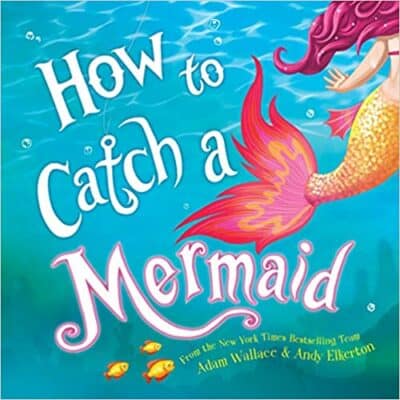
Editor’s Rating:
Quick Facts:
- Reading Level: Ages 4-10
- Pages: 40 pages
While at the beach, a young girl plans how she can catch a mermaid with her friend and her dog.
Why Your Six-Year-Old Might Like It
If you have a child that is obsessed with mermaids, this book is a must-have for your home library. Your child will love the vivid, colorful pictures and the various schemes the characters come up with to catch a mermaid.
Reading Practice
This book rhymes from start to finish! You can use the rhyming words in the story to explore and practice phonics skills and learn more about new letter-sound relationships.
Learning Opportunities
Though some parents were disappointed that sharks were characterized as bad, you could use this as a learning opportunity for your kid to talk about the differences between what they see in movies, books and television versus the real world.
Pros
- Vivid images
- Fun and educational rhyming
- 5-book series
Cons
- Characterizes sharks as evil
6. Best Poetry Book for Six-Year-Olds: Where the Sidewalk Ends by Shel Silverstein
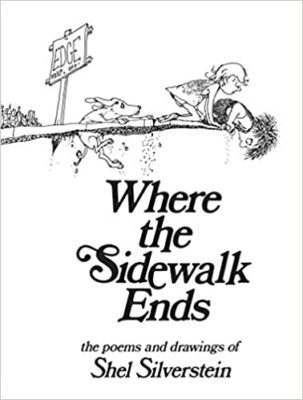
Editor’s Rating:
Quick Facts:
- Reading Level: Ages 6-8
- Pages: 176
- Book Awards: ALA Notable Book, Outstanding Book Award
There is no plot to this poetry book. It is filled with imaginative, funny and weird poems your child will certainly love. Newer editions of this book have been edited for political correctness issues, which some parents have found frustrating.
Why Your Six-Year-Old Might Like It
Though the illustrations are simple in form, kids love them! They are imaginative and engaging, and they perfectly illustrate the most interesting parts of each poem, exciting your child’s imagination. Each poem is extremely relatable to a child’s silly side, so be prepared to laugh along with your kid while reading through this book.
Reading Practice
Like How to Catch a Mermaid, the rhyming patterns in this book will help your child in learning more about letter-sound relationships and practice decoding.
Learning Opportunities
There are as many heartwarming poems in this book as there are silly ones. Many of these poems will encourage your child to ask questions and engage in discussions about love, family and friendship.
Pros
- Illustrations are fun and engaging
- Poems are silly, fun and relatable to young readers
- Great learning opportunities for phonics and decoding
Cons
- Newer editions of the book have changed wording in some poems
7. Best Rhyming Book for Six-Year-Olds: One Fish, Two Fish, Red Fish, Blue Fish by Dr. Suess
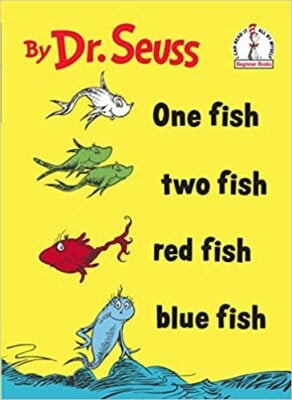
Editor’s Rating:
Quick Facts:
- Reading Level: Ages 3-7
- Pages: 63
In this book, readers will explore a world full of funny things through rhymes. Characters like the bumpy Wump and the winking Yink who drinks pink ink are some of many things you’ll come across in this story. Some parents are unhappy with the lack of a meaningful plot as the book focuses more on making silly rhymes.
Why Your Six-Year-Old Might Like It
Each page is full of fun, colorful and silly illustrations of the even sillier characters. Every page engages their imagination and provides them opportunities to read the book by talking about what they see in the pictures, making the reading process less overwhelming for beginning readers.
Reading Practice
Like Where the Sidewalk Ends, the silly rhyming words, help kids expand their phonics knowledge and practice decoding skills.
Learning Opportunities
Kids love and find it easy to memorize the lines of this book. This is an excellent way to encourage young readers to love the act of reading, especially if they are new to reading or have special learning needs.
Pros
- Illustrations engage the imagination
- Rhymes are silly, making reading fun for kids
- Rhymes help kids practice phonics and decoding
Cons
- There is no true plot to the story, just silly rhymes
8. Best Book for Advanced 6-Year-Old Readers: Dog Man, The Epic Collection #1-3 Box Set by Dav Pilkey
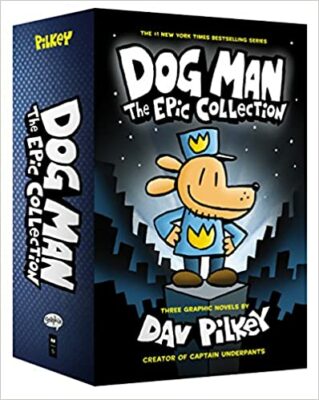
Editor’s Rating:
Quick Facts:
- Reading Level: Ages 7+
- Pages: 576
When Greg the police dog and his cop partner get injured on the job, they undergo a life-saving surgery to become Dog Man. In this box set series comes the first three stories of this new half-man, half-dog, crime-fighting hero: Dog Man, Dog Man Unleashed and Dog Man: A Tale of Two Kitties.
Some parents find the origin story of Dog Man (he gets blown up by a bomb) to be unsettling and overly violent.
Why Your Six-Year-Old Might Like It
The comic book graphics are eye-catching and addictive for any six-year-old to explore who loves illustrations. There is also a certain amount of potty humor that young readers enjoy laughing about.
Reading Practice
The speech bubbles, different font sizes and colors encourage your child to not only read with expression, but also to read with different voices for each character.
Learning Opportunities
Some parents have noted that this book series has encouraged their kids to get more into drawing and illustrations. In addition to this, Pilkey uses the story of Dog Man to explore positive themes like empathy, kindness and being true to yourself.
Pros
- Illustrations are fun and engaging
- Speech bubbles encourage reading with expression and different voices
- Explores universal themes related to empathy and kindness
Cons
- Some parents have found the origin story of Dog Man too violent
9. Best Sing-Along Book: Pete the Cat: I Love My White Shoes by Eric Litwin

Editor’s Rating:
Quick Facts:
- Reading Level: Ages 4-8
- Pages: 40
Pete the Cat goes on a walk in his brand new white shoes. Along the way, he steps into various types of fruit which turn his shoes different colors along the way. Instead of getting upset, Pete the Cat keeps up a positive attitude and sings along with the changes.
There are some compatibility issues with specific Kindle readers, depending on the book version you buy, so be sure to check the book out ASAP and get a refund if it doesn’t work for you.
Why Your Six-Year-Old Might Like It
Your six-year-old will definitely love the sing-along aspect of this story. If that’s not enough, they’ll get to guess which color Pete’s shoes will change into after he steps into each type of fruit.
Reading Practice
This book presents an excellent opportunity for your child to recognize and practice reading color sight words.
Learning Opportunities
Pete the Cat teaches kids how to maintain a positive attitude when things change.
Pros
- Great for sing-alongs
- Excellent book for practicing reading/recognizing color sight words
- Teaches kids how to maintain a positive mindset
Cons
- Some Kindle readers are not compatible with specific versions of this book
10. Best Book for Empowering Six-Year-Old Girls: The Paper Bag Princess by Robert Munsch
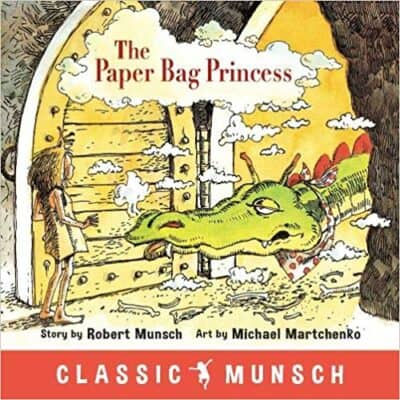
Editor’s Rating:
Quick Facts:
- Reading Level: Ages 4-7
- Pages: 32
When a dragon destroys Princess Elizabeth’s castle, burns all of her clothes and takes her fiancé captive, she must rely on herself to save him. Using her wits and wearing a plain paper bag, she challenges the dragon to see just how strong he is.
Why Your Six-Year-Old Might Like It
This is an excellent book for boys and girls alike. It encourages girls to see themselves as heroes which is not always a common narrative they see on TV or in movies. It also shows boys that it is okay if they need other people to help them solve problems. The illustrations are vivid and engaging. However, the book is quite tiny, so it’s not great for bedtime reading.
Reading Practice
Each page of this book is text-heavy, so if your child is a beginning reader, it is best for you to read this out loud to them. However, as your child develops and grows as a reader, this book is a great tool to use to practice reading fluency.
Learning Opportunities
This book breaks down gender stereotypes, showing that girls can be heroes and boys can rely on others to help save them from trouble.
Pros
- Empowers young girls to be problem-solvers
- Encourages boys to let others help them during conflicts
- Vivid and engaging illustrations
Cons
- Book is really small in size
- Might be too complex for beginning readers
11. Best Book for Joke-Lovers: Awesome Jokes that Every Six-Year-Old Should Know by Mat Waugh and Yurko Rymar
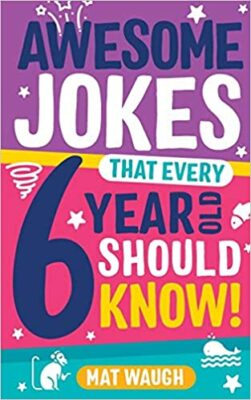
Editor’s Rating:
Quick Facts:
- Reading Level: Ages 5-8
- Pages: 69
There is no plot to follow in this non-fiction book. Each page has one to two jokes on them with a catchy illustration, making it perfect for picking up and reading through in short bursts.
Why Your Six-Year-Old Might Like It
Kids love jokes! This is a fun book for kids to explore and share with their family and friends. The illustrations add to the fun, which is especially helpful because some of the jokes may be too hard for young kids to understand without help.
Reading Practice
Telling jokes is a great way to practice reading phrases and sentences with fluency to deliver a joke to an audience effectively.
Learning Opportunities
Though the book does not teach any universal lessons, it can be used to promote social skills like sharing, finding common interests, etc.
Pros
- Funny jokes and accompanying illustrations
- Fun to explore with family and friends
- Great for practicing fluency
Cons
- Some jokes may be too hard for young kids to understand
12. Best Book for Curious Minds: Ada Twist, Scientist by Andrea Beaty
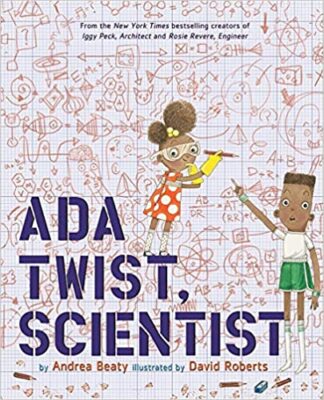
Editor’s Rating:
Quick Facts:
- Reading Level: Ages 5-7
- Pages: 32
Ada Twist is a young girl who is full of questions! Whether her experiments or fact-finding missions are successful or not, Ada comes to understand just how important it is to think through problems and to keep asking questions.
Some parents were unhappy with how the main character’s mom and dad are portrayed. They are often discouraging to Ada when she asks questions and tries to discover their answers.
Why Your Six-Year-Old Might Like It
The illustrations are fun and some of them even look like real kid’s drawings. Six-year-olds are incredibly curious people who have a lot of questions about the world around them in this phase of life, so seeing a main character who acts just like them is encouraging and empowering.
Reading Practice
Certain words and phrases in the book are in larger fonts and emphasized, encouraging your child to read with expression.
Learning Opportunities
This book teaches kids to continue being curious, to keep asking questions and to keep experimenting to find answers, even when things don’t go as planned.
Pros
- Empowering to young girls
- Encourages asking questions and conducting experiments
- Teaches kids to be and stay curious
Cons
- Main character’s parents are often depicted negatively
13. Best Interactive Book: Don’t Let the Pigeon Drive the Bus! by Mo Willems
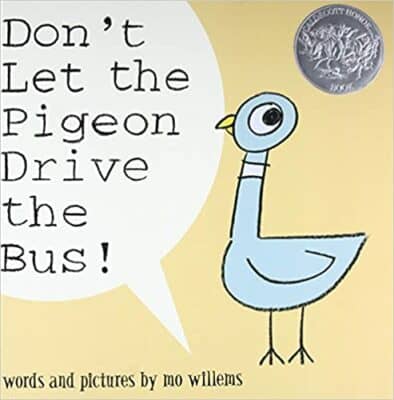
Editor’s Rating:
Quick Facts:
- Reading Level: Ages 2-6
- Pages: 40
- Book Awards: Caldecott Award
A bus driver wants to take a break from driving, and a pigeon steps in and talks to the reader, begging and pleading with them to let him drive the bus! Some parents didn’t like their children constantly having to say “no” to the pigeon when he asks to drive the bus and feel that the story should be more positive.
Why Your Six-Year-Old Might Like It
Similar to Don’t Let the Pigeon Drive the Bus!, the reader feels like they are in direct engagement with the main character.
Reading Practice
The speech bubbles and different sizes and colors of text encourage your child to read with expression.
Learning Opportunities
This book explores what it’s like to have a temper tantrum, a common experience for six-year-olds. You can use this book to help your child learn better, more positive ways to respond to “no.”
Pros
- Fun and interactive and lets your child take charge of the story
- Teaches kids how to appropriately deal with their anger
- Speech bubbles encourage reading with expression
Cons
- Kids will have to say “no” a lot to the pigeon
14. Best Book for Showing Different Perspectives: The True Story of the Three Little Pigs by Jon Scieszke

Editor’s Rating:
Quick Facts:
- Reading Level: Ages 5-8
- Pages: 32
Everyone knows the story of the three little pigs and their battle with the big, bad wolf. But that’s just from the pig’s perspective. In this book, the wolf tells you what really happened.
Why Your Six-Year-Old Might Like It
It is a fun take on a classic story. Kids will love the challenge of seeing the pigs as the bad guys instead of the wolf. The illustrations fill each page and tell the wolf’s side of the story in colorful detail, but the illustrations of the wolf eating the first and second pig may be too graphic for sensitive six-year-olds.
Reading Practice
This book is best to read aloud to beginning readers. Emerging and more advanced readers can use this book as a way to practice their reading fluency.
Learning Opportunities
The True Story of the Three Little Pigs is a great way to teach kids about differing perspectives. There’s always more than one way to tell the same story, and this book clearly demonstrates that.
Pros
- A fun twist on a classic
- Lots of entertaining illustrations
- Teaches children to view things from multiple perspectives
Cons
- Contains scenes of violence
15. Best Book for Encouraging Creativity: The Dot by Peter H. Reynolds
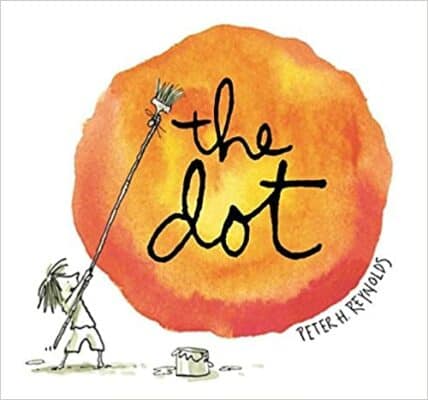
Editor’s Rating:
Quick Facts:
- Reading Level: Ages 7-9
- Pages: 32
- Book Awards: Christopher Award
Trying to prove to her art teacher that she is not an artist, Vashti makes an angry dot on her blank piece of paper. However, the dot she creates leads her on a journey of discovery as she learns how creativity can happen in different ways and what it truly means to be an artist.
Why Your Six-Year-Old Might Like It
Kids will relate to the main character’s feelings of insecurity at trying new things. As Vashti explores what she can do with a single dot in creating new things, kids will be inspired to explore their own imaginations.
Reading Practice
The text stays virtually the same throughout the story, so there is not a lot of opportunity to directly practice phonics or decoding. Emerging and advanced readers can use this text to practice their reading fluency.
Learning Opportunities
The Dot teaches young kids not to be afraid of being the “perfect” anything, especially when it comes to creating art. Creativity can come from anywhere and look like anything your imagination can come up with!
Pros
- Encourages young artists to take risks and think positively
- Main character is relatable to common insecurities young people feel
- Teaches kids that they don’t have to be “perfect”
Cons
- Not an ideal book for explicit reading practice for phonics or decoding
16. Best Humorous Book: We Don’t Eat Our Classmates by Ryan T. Higgins

Editor’s Rating:
Quick Facts:
- Reading Level: Ages 3-5
- Pages: 48
On Penelope’s first day of school, she feels excited to meet her fellow classmates. But there’s one problem: she’s a dinosaur, her classmates are human and she thinks they taste mighty delicious! Some have found that the overall lesson/message in the story gets lost in the plot at times.
Why Your Six-Year-Old Might Like It
Most kids are fascinated by dinosaurs at this age, so having a main character who’s a dinosaur in a classroom full of kids she wants to eat is a hilarious book for any six-year-old to read! The illustrations are large, colorful and fill every page.
Reading Practice
Each page has a small amount of text, so this is a great book to use to help beginning readers practice their fluency.
Learning Opportunities
This book teaches kids that it is possible to learn new things and to adapt to new situations, even when it feels like change is impossible.
Pros
- Great lesson on respect for social development
- Interesting and engaging illustrations
- Great for beginning readers to practice fluency
Cons
- Plot/overall message may be hard to follow at times
17. Best Book for Reading with Grandparents: Last Stop on Market Street by Matt de La Peña
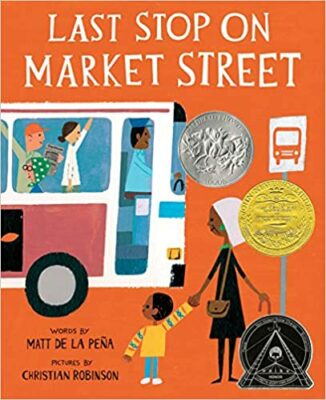
Editor’s Rating:
Quick Facts:
- Reading Level: Ages 3-5
- Pages: 32
- Book Awards: Caldecott & Newbery Medal
CJ and his grandmother ride the bus together after church on Sundays. On these rides, he often wonders why his grandma and people like them don’t have the same things as other people. As he asks these hard questions, his grandma helps him understand his world and the world around him through her kind-hearted answers.
Why Your Six-Year-Old Might Like It
Kids will enjoy the simple yet captivating illustrations of C.J, his grandmother and the neighborhoods they travel through. Though the story content and text may be complex at times for readers, seeing a main character their age asking questions about the world around them and why things are the way they are is extremely relatable.
Reading Practice
There are not many opportunities to explicitly practice phonics or decoding skills, but the text is great for more advanced six-year-old readers to practice their fluency.
Learning Opportunities
This is a story that is all about questioning why people around them live in different ways. It is a great way to talk about differences, diversity and equality.
Pros
- Excellent at showcasing diversity
- Generates conversations about equity and differences
- Main character is relatable to other kids who are curious about the world
Cons
- Text and story content may be complex at times for young learners
18. Best Book for Breaking Male Stereotypes for Six-Year-Old-Boys: Julián is a Mermaid by Jessica Love
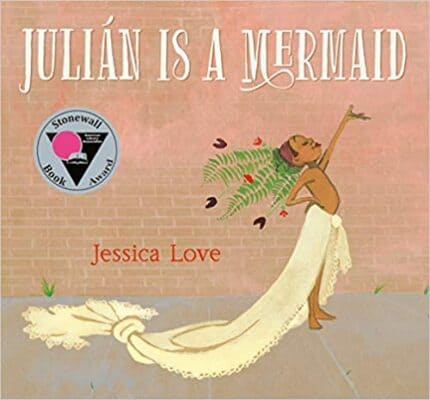
Editor’s Rating:
Quick Facts:
- Reading Level: Ages 4-8
- Pages: 40
On a subway ride, Julián sees three women dressed up in beautiful costumes. He is immediately fascinated with their look, and when he gets home, he daydreams about making the perfect mermaid costume for himself.
Why Your Six-Year-Old Might Like It
The illustrations are beautifully drawn and depict a diverse group of people. If your child has been feeling particularly underrepresented in the books, films and television they see, this book will help demonstrate that stories can be about people who look just like them! Plus, teaching all children to be respectful of others is an excellent lesson—though some conservative parents may have issues with the message.
Reading Practice
The limited text and changes in font sizes encourages kids to practice reading with expression and fluency. It is particularly helpful for readers who are in the early stages of literacy development.
Learning Opportunities
This is an excellent book to help both boys and girls break down gender stereotypes. This main character, Julián, daydreams about dressing up as a mermaid, and learns to accept himself as he is, even after being bullied by others. More conservative parents will find this story uncomfortable.
Pros
- Breaks down gender stereotypes
- Teaches kids to be true to themselves no matter what
- Kids can practice reading with fluency and expression
Cons
- Parents who are more on the conservative side may find this story uncomfortable
19. Best Book for Beginning Readers: We Are in a Book! (An Elephant and Piggie Book) by Mo Willems
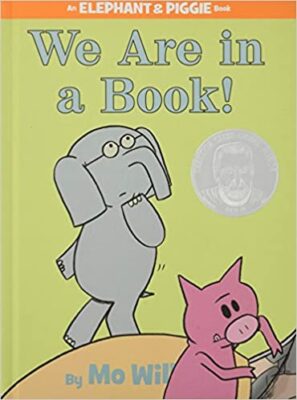
Editor’s Rating:
Quick Facts:
- Reading Level: Ages 3-5
- Pages: 64
- Book Awards: Geisel Medal
Similar to The Book with No Pictures, when Piggie and Elephant realize that they are in a book (and that the reader is reading them right now), they have loads of fun… at first. But then Elephant realizes that the book will eventually end!
Why Your Six-Year-Old Might Like It
Young readers love when characters break the fourth wall, and this story does just that. The main characters behave in silly and fun ways, which leads to lots of laughs while reading the story from start to finish.
Some kids got bored with the story after a while as the content is simple and not very text or illustration heavy, but this makes it great for readers transitioning from picture books to simple text.
Reading Practice
The speech bubbles and differing font sizes encourage readers to practice reading with expression and different voices for each character.
Learning Opportunities
Elephant’s distress about the book eventually ending helps readers learn how to positively cope with stress and anxiety.
Pros
- Main characters talk directly to the reader
- The speech bubbles encourage reading with expression and character voices
- Elephant teaches readers how to deal with stress and anxiety
Cons
- Some kids may find the simple drawings and limited text boring
20. Best Book to Read with Teachers: Miss Nelson is Missing by Harry G. Allard
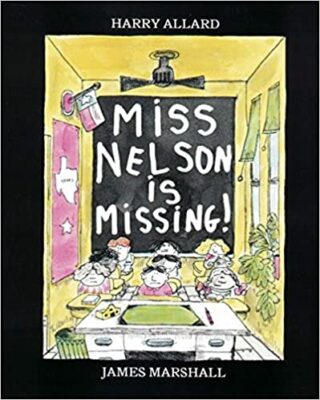
Editor’s Rating:
Quick Facts:
- Reading Level: Ages 4-7
- Pages: 32
The kids in Miss Nelson’s class are very naughty. They don’t like to listen to her, and they don’t follow the rules. When Miss Nelson is sick at home, and their substitute teacher, Miss Viola Swamp comes to teach the kids while she’s away, the kids learn just how much they took Miss Nelson for granted!
Some parents may find the stereotype of the “mean teacher” to be unhelpful in helping readers learn the ultimate lessons of the book, but it’s a lot of fun for kids (and most adults).
Why Your Six-Year-Old Might Like It
Kids love reading about other kids who are being naughty! It’s a fun way to explore the idea of breaking rules from a safe distance. The kids will also love the mystery of trying to find out exactly who Miss Viola Swamp is and where she came from.
Reading Practice
Some pages can be quite text heavy, so it is best to read this book aloud to your kid if they are still in the early stages of learning how to read. However, as they progress, you can use this book to help them practice reading fluency.
Learning Opportunities
This book is all about learning how to respect teachers and appreciate them for the good things they do to help their kids learn.
Pros
- Kids will love trying to figure out exactly who Miss Swamp is
- Great for more advanced readers to practice fluency
- Overall lesson about appreciating supportive teachers is positive
Cons
- Some parents dislike the “mean teacher” stereotype
Final Thoughts on Books for 6-Year-Olds
The best part about reading with this age group is that they are excited to explore almost every book they come across! It is an excellent time to enjoy reading with your child in a variety of ways: you can read to them before bedtime, you can explore a book together with a nice cup of hot cocoa or they might even want to read to you when they come home from school. The most important things are to choose a variety of books, to make sure that they are about things your child likes and to read with them everyday in any way possible.
Happy reading!
